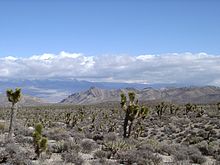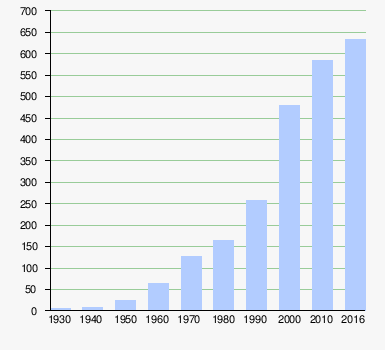Las Vegas
![]()
This article is about the city of Las Vegas in Nevada; for other meanings of "Las Vegas", see Las Vegas (disambiguation).
Las Vegas [lɑs ˈveɪgəs] is the largest city in the US state of Nevada. It is best known for the many casinos that have settled mainly along the Las Vegas Strip. The population in an area of 340 square kilometres is approximately 651,000 (2019 estimate), and the agglomeration spreads over more than 1200 square kilometres, with a total population of nearly two million. Las Vegas is the administrative seat of Clark County. The name comes from the Spanish for "The Meadows" or "The Meadows". The city is also known for its large number of wedding chapels ("Wedding Chapels"), as Nevada has uncomplicated marriage and divorce laws. Of all U.S. cities, the gap between rich and poor is widest in Las Vegas; in Las Vegas, life expectancy for poor people is far below the national average.
Artists working in Las Vegas included musicians such as Elvis Presley, The Rat Pack with Frank Sinatra, Sammy Davis, Jr. and Dean Martin, Céline Dion, Johnny Cash, Elton John and illusionists such as Siegfried and Roy, David Copperfield, Criss Angel and Cirque du Soleil.
In 2019, about 42 million people traveled to Las Vegas. Casinos and shows shaped the city.
Climate
The climate of Las Vegas is a desert climate (BWh) with long, very hot, dry summers and short, cool winters.
| Las Vegas | ||||||||||||||||||||||||||||||||||||||||||||||||
| Climate diagram | ||||||||||||||||||||||||||||||||||||||||||||||||
| ||||||||||||||||||||||||||||||||||||||||||||||||
| Monthly average temperatures and precipitation for Las Vegas
Source: World Meteorological Organisation Climatological data are based on monthly averages from 1961 to 1990; wetterkontor.de | ||||||||||||||||||||||||||||||||||||||||||||||||||||||||||||||||||||||||||||||||||||||||||||||||||||||||||||||||||||||||||||||||||||||||||||||||||||||||||||||||||||||||||||||||||||||||||||||||||||||||||||||||||||||||||||||||||||||||||||||||||||||||||||

Typical desert landscape around Las Vegas
Population
→ Main article: Las Vegas demographics
| Population development | |
| Year | Inhabitants¹ |
| 1930 | 5.165 |
| 1940 | 8.422 |
| 1950 | 24.624 |
| 1960 | 64.405 |
| 1970 | 125.787 |
| 1980 | 164.674 |
| 1990 | 258.295 |
| 2000 | 480.042 |
| 2010 | 584.313 |
| 2016 | 632.912 |
Las Vegas is Nevada's largest city with a population of 632,912 (2016) and was the 28th largest city in the United States in 2016. With a land area of 339.8 km², this corresponds to a population density of 1,862 inhabitants per square kilometre. Annual population growth is 2.0 percent (average, 2000-2008). The closed settlement area (Urban Area) of Las Vegas has 1.31 million inhabitants, the metropolitan area 1.87 million.
Las Vegas was founded in 1905 as a railroad town and grew rapidly from the beginning. In the 1940s, the population exceeded 10,000, and 20 years later, the city already had 100,000 residents. Between 1990 and 2016, the population more than doubled. Due to the now dense settlement of the urban area, growth is increasingly shifting to the suburbs of the metropolitan region, which have now reached the mountainous area.
A young city even by American standards, Las Vegas is heavily influenced by immigration. In 2008, 78 percent of residents were born outside of Nevada. Immigration from abroad (predominantly from Mexico) has increased significantly in recent decades - while in 1990 only one in ten residents was born abroad, this figure has now risen to almost one in four. The proportion of foreigners has risen from six percent to 15 percent in the same period. Just under half of the residents are non-Hispanic whites (47.9 percent), although their share is clearly declining. In 2009, Las Vegas became what is known as a Majority-Minority City. This means that non-Hispanic whites, who make up a slim two-thirds majority nationwide, make up less than half of the residents in their respective cities. Hispanics are the second-largest and fastest-growing demographic group at 31.5 percent: in 1980, their share was 7.8 percent.
English is the primary language for two-thirds of Las Vegas residents. Due to the immigration of Latin Americans, the proportion of Spanish has increased sharply in recent years, so that it is now used by a quarter of the population at home. The other languages together account for eight percent. Overall, 16 percent of respondents say they do not speak English very well.
Las Vegas had the highest suicide rate in the United States in 2007.

.png)
Illustration of ethnic population distribution in Las Vegas in 2010. white , black, Asian , Latino .
Questions and Answers
Q: What is Las Vegas?
A: Las Vegas is a city in the American state of Nevada.
Q: How many people lived in Las Vegas in 2015?
A: There were 640,932 people living in the city in 2015.
Q: How many people live in the metropolitan area of Las Vegas?
A: More than 2,000,000 people live in the metropolitan area of Las Vegas.
Q: Is Las Vegas the largest city in Nevada?
A: Yes, Las Vegas is the largest city in Nevada.
Q: Who is the mayor of Las Vegas?
A: Carolyn Goodman became the mayor in 2011.
Q: What is the county seat of Clark County?
A: Las Vegas is the county seat of Clark County.
Q: What state is Las Vegas in?
A: Las Vegas is in the American state of Nevada.
Search within the encyclopedia